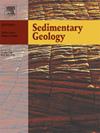Environmental and oceanographic evolution in the Southern Qiangtang Basin (eastern Tethys) during the latest Pliensbachian to early Toarcian (Early Jurassic)
IF 2.9
2区 地球科学
Q1 GEOLOGY
引用次数: 0
Abstract
The late Pliensbachian-early Toarcian (Early Jurassic) interval is marked by significant climatic changes that affected environmental and paleoceanographic conditions, impacting biogeochemical cycles, as well as marine and terrestrial ecosystems. The most profound environmental changes occurred across the Pliensbachian/Toarcian boundary (P/T B) and in the early Toarcian. Both events align with phases of increased greenhouse gas emissions, global warming, sea-level rises, intensified hydrological cycles, and continental weathering. The Toarcian coincides with the expansion of oxygen-deficient conditions in oceanic and at various shelf areas, marking the Toarcian Oceanic Anoxic Event (T-OAE). In this study, we present high-resolution inorganic geochemical data from the Qixiangcuo section of the Southern Qiangtang Basin, which records both the P/T B and early Toarcian events. The section studied reflects a shallow shelf environment in northeastern part of the Tethys Ocean. Element ratios, such as Ti/Al and Zr/Al, interpreted as sediment grain size proxies, reveal characteristic changes that can be linked to the interplay between sea-level changes and shifts in continental weathering and terrigenous sediment influx. Secular trends in these grain-size proxies reflect sea-level dynamics during the late Pliensbachian-early Toarcian, with notable transgressions at the P/T B and early Toarcian. The early Toarcian event further coincides with increased terrigenous material in response to an intensified hydrological cycle, as evidenced by transient increases in grain-size proxies and higher paleo-weathering indices (e.g., ln(Al2O3/Na2O)). Despite the increased nutrient flux to the paleo-shelf sea, enrichment factors (EF) of productivity proxies (ZnEF, CuEF, BaEF, NiEF) do not show increases in organic matter export to the sediments. Thus, organic matter-lean sediments (total organic carbon <0.5 wt%) have accumulated in the Southern Qiangtang Basin during the latest Pliensbachian-early Toarcian. The lack of enrichment in redox-sensitive elements, such as Mo, V, and U in the sedimentary rocks of the Qixiangcuo section, points to a well‑oxygenated environment. Accordingly, although the T-CIE is identified in the study section, the T-OAE did not develop in this paleogeographic area. The new data thereby highlight the role of local-regional paleoenvironmental and paleoceanographic parameters as important factors contributing to the genesis of the T-OAE and the burial of organic carbon in marine sediments.
羌塘盆地南部(特提斯东部)晚Pliensbachian -早陶瓦良世(早侏罗世)环境与海洋演化
晚普林恩巴氏—早陶瓦世(早侏罗世)时期,气候发生了重大变化,影响了环境和古海洋条件,影响了生物地球化学循环,影响了海洋和陆地生态系统。最深刻的环境变化发生在Pliensbachian/Toarcian边界(P/T B)和Toarcian早期。这两个事件都与温室气体排放增加、全球变暖、海平面上升、水文循环加剧和大陆风化的阶段相一致。Toarcian ocean Anoxic Event (T-OAE)标志着Toarcian oceanic Anoxic Event (T-OAE)的发生。本文采用高分辨率的无机地球化学资料,记录了羌塘盆地南部七相措剖面的P/T B和早陶瓦世事件。所研究的剖面反映了特提斯洋东北部的浅层陆架环境。元素比率,如Ti/Al和Zr/Al,被解释为沉积物粒度指标,揭示了与海平面变化、大陆风化变化和陆源沉积物流入之间的相互作用有关的特征变化。这些粒度指标的长期趋势反映了pliensbachia晚期- Toarcian早期的海平面动态,在P/T B和Toarcian早期有明显的海侵。早陶拉纪事件进一步与陆源物质的增加相吻合,这是对强化水文循环的响应,这可以通过粒度指标的短暂增加和古风化指数(如ln(Al2O3/Na2O))的升高来证明。尽管向古陆架海的养分通量增加,但生产力指标(ZnEF、CuEF、BaEF、NiEF)的富集因子(EF)并未显示有机质向沉积物输出增加。因此,羌塘盆地南部在晚普林恩巴氏—早陶拉世形成了有机质贫沉积(总有机碳含量为0.5 wt%)。七相错剖面沉积岩中Mo、V、U等氧化还原敏感元素缺乏富集,表明其为富氧环境。因此,虽然在研究区发现了T-CIE,但在该古地理区没有发育T-OAE。因此,这些新数据强调了局部区域古环境和古海洋参数是影响T-OAE成因和海洋沉积物中有机碳埋藏的重要因素。
本文章由计算机程序翻译,如有差异,请以英文原文为准。
求助全文
约1分钟内获得全文
求助全文
来源期刊

Sedimentary Geology
地学-地质学
CiteScore
5.10
自引率
7.10%
发文量
133
审稿时长
32 days
期刊介绍:
Sedimentary Geology is a journal that rapidly publishes high quality, original research and review papers that cover all aspects of sediments and sedimentary rocks at all spatial and temporal scales. Submitted papers must make a significant contribution to the field of study and must place the research in a broad context, so that it is of interest to the diverse, international readership of the journal. Papers that are largely descriptive in nature, of limited scope or local geographical significance, or based on limited data will not be considered for publication.
 求助内容:
求助内容: 应助结果提醒方式:
应助结果提醒方式:


